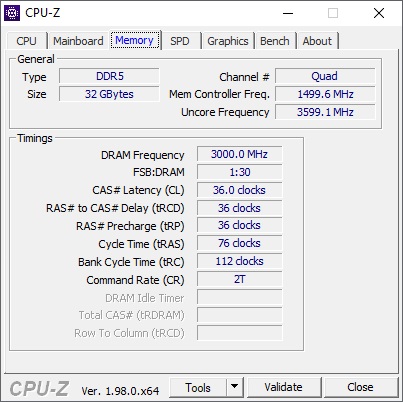Intel Alder Lake DDR5 Memory Scaling Analysis With G.Skill Trident Z5
by Gavin Bonshor on December 23, 2021 9:00 AM ESTG.Skill Trident Z5 Memory (F5-6000U3636E16G)
2x16GB of DDR5-6000 CL36
For the purposes of this article and to investigate scaling performance on Alder Lake, G.Skill supplied us with a kit of its latest Trident Z5 DDR5-6000 CL36 memory. The G.Skill Trident Z series has been its flagship model for many years, focusing on performance but blending in a premium and clean-cut aesthetic. G.Skill offers two types of its Trident Z5 memory, some without RGB LEDs such as the kit we are taking a look at today (Z5), and the Trident Z5 RGB, which includes an RGB LED light bar along the top of each memory stick.
Focusing on the non-RGB variants, the G.Skill Trident Z D5 is available in various 32 GB (2x16) configurations starting at DDR5-5600 CL36 and ranging up to DDR5-6000 CL36. G.Skill unveiled a kit of Trident Z D5 RGB DDR5-7000 CL40 kit, which is extremely fast, and when it is released, it will ultimately be one of the most, if not the most, expensive DDR5 memory kit on the market.
Looking at the design, the G.Skill Trident Z5 DDR5 memory uses a 42 mm tall (at the highest point) heatsink, with G.Skill offering a two-tone contrasting matte black kit, as well as a black and metallic silver kit. The kit supplied to us by G.Skill uses two-tone matte black heatsinks. The heatsinks are constructed from aluminum, and G.Skill states that it uses a newer and more 'streamlined' design. There are quite pointy, which given previous G.Skill memory kits might have the tendency to feel too sharp when installing them.
Looking at what CPU-Z is reporting, we can see that the X.M.P 3.0 profile matches up with the advertised specifications, with this particular kit using DDR5-6000 with latency timings of 36-36-36-76. The operating voltage for the kit is 1.3 V, which is a 0.2 V bump from the JEDEC SPD rating of this kit, which is DDR5-4800 at 1.1 V.
Checking the more intricate details of the G.Skill Trident Z5 DDR5-6000 memory, CPU-Z reports that the kit is using Samsung IC's, with a 1Rx8 array of 16 Gb ICs employed on each module. While CPU-Z doesn't actually report this, we reached out to G.Skill who informed us that this kit uses a single rank design.













82 Comments
View All Comments
Targon - Thursday, December 23, 2021 - link
Looking at these numbers, and how DDR5-5800 and DDR5000 both seem to have a performance penalty, but the other numbers aren't all that different implies something in the Alder Lake design or BIOS or SOMETHING isn't making very good use of the memory.Some may just chalk it up to the RAM, but I suspect it has more to do with Alder Lake itself supporting both DDR4 and DDR5 memory. At that point, I suspect the memory controller on the CPU and how it links to the CPU cores is at fault. If the memory controller were actually making better use of the changes in DDR5 compared to 4(dual 32 bit per clock eliminating certain wait states as one example), then we SHOULD see a definite improvement with better memory and not this trivial difference.
It will be interesting to see if AMD Zen4 Ryzen shows better scaling between memory speeds, because if there is, that will show very clearly how poorly Intel implemented DDR5 memory support. Just getting it working isn't the same as taking advantage of the benefits.
mikk - Thursday, December 23, 2021 - link
They didn't test the RAM, it's a GPU test. It's called GPU limit.haukionkannel - Friday, December 24, 2021 - link
AMD use most likely more cache, so the difference will be smaller.felixbrault - Thursday, December 23, 2021 - link
Why is Anandtech still using Windows 10 for testing?!?Ryan Smith - Thursday, December 23, 2021 - link
Windows 11 has been very, er, "quirky" to put it politely. We're keeping an eye on it and running it internally, but thus far we've found it to be rather inconsistent on performance benchmarks.In the interim, even when it behaves itself and doesn't halve our results for no good reason, we just end up with results similar to Windows 10. So there's no net benefit to using it right now.
Oxford Guy - Friday, December 24, 2021 - link
Probably because Windows 11 is worse than 10.Samus - Thursday, December 23, 2021 - link
So basically the same story as ever, good timings mean almost as much as frequency, and paying ultra premiums for frequency still don't net reasonable returns on the investment.As always, just stick with reliable, quality memory at JEDEC speeds and invest the savings elsewhere.
Oxford Guy - Friday, December 24, 2021 - link
‘quality memory at JEDEC speeds’Lol, no. Certainly not with a CPU like Zen 1. There was a huge difference between JEDEC and 3200-speed DDR-4, without a huge cost increase. Zen 3 is optimal at 3600. I would think you’re aware of the fabric speed being tied to the RAM speed, hence there being a price-performance sweet spot. That spot hasn’t been JEDEC for a long time.
Your point may apply to early adopter RAM at most. Once the DDR-5 market is more mature... In this situation it looks like getting Alder with DDR-4 capable of low latencies is most optimal. Too bad there’s no data on that here.
TheinsanegamerN - Monday, January 3, 2022 - link
JEDEC DDR3 was 1066, and later updated to 1333 when everyone was running 1866 or 2133.JEDEC ddr4 is 2133 mhz, up to 2666, when 3200-3600 is the performance sweet spot.
haukionkannel - Friday, December 24, 2021 - link
Well it seems that we are not memory speed bottle necked at the current state...And timings seems to affect more than pure band wide.